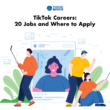Molood Ceccarelli is a Remote Work Strategist, the founder and CEO of Remote Forever, and an international keynote speaker. She has also created the Remote Forever Summit, the first virtual summit for distributed agile. She is an Agile coach, consultant, certified Scrum Master, and Scrum coach.
First, some backstage, director’s cut footage. I knew my conversation with Molood was going to be great from the moment we first interacted. I asked her where she was from, and she immediately rebutted that that was a bad question. It could lead me to assume things about her based on her birthplace, and that wasn’t necessarily who she was. She told me that a much better question would be “Where are you based?”
This is the attitude of a person who makes things happen. Molood has been one of my favorite people ever since.
In this article you will learn:
- A frame of mind to help you evaluate the utility of old processes
- How to help people adapt to remote work
- Building an agile team in a remote environment
- How to fight isolation and the value (or not) of workplace friendships
- An argument for increased transparency in team communication
- Why you should take responsibility before judging others
- Bonus: Why you should look at your work as if it is art
Remote Work and Putting Your Money Where Your Mouth Is
One of my pet peeves pre-COVID was how people traveled thousands of miles to sit at conferences hearing someone tell them how remote work was the future. Molood shared this frustration, but unlike me, she did something about it. This was one of the driving factors behind her founding her own conference, the Remote Forever Summit:
If you want to talk about remote work and you ask people to take a plane and go to a physical space and be in a physical room... Well, no, not really. I decided I was going to create the experience of a conference, of connecting with an audience, of connecting with the speakers, all remotely. That’s what we do.
She went on to explain that her decision was really an extension of the Agile principles that she works by:
We had to practice what we preach, which is being agile. For those people in the audience who don’t know what it is, in essence, it’s valuing people and interactions over processes and tools. It’s building processes and building relationships in the business so that your business can adapt to the changes in the market.
How Many of Us Are Working With The Mental Equivalent of an Old Ericsson Phone
As we dove further into the topic of change — how change was needed in the workplace if we were to make the most of remote work and the opportunities it gives us — Molood came up with one of the best analogies I’ve ever encountered. She brought forth the power of conditioning that leads to counter-productivity. She spoke about how we become set in our ways of working. This is a Jedi Mind trick I’ve since often used when a process feels counter-intuitive. I ask myself: “Am I using the equivalent of an old Ericsson phone?” I’ll let Molood explain, quoting Joshua Kerievski, founder of the “Modern Agile” movement:
”If you want to give someone a phone who has never ever used a mobile phone… They’ve never owned a phone, maybe your grandmother or someone, and they want to start using a smartphone, would you give them one of those huge brick-sized Alcatel or Ericsson phones and say, “Start with this and build yourself up to an iPhone or a modern Android phone”? Do you do that? Do you give them all those old practices and tell them to build their way up to it? No, we don’t. So, why do we go out there and say, “Start with the scrum that was made in the ’80s and build yourself up from there”? We don’t do that.”
Molood then expanded on this notion of staying truer to rigid ideas instead of the principles that generated them in the first place. The idea is that if you stay true to the original principles (in the case of Agile, people, and relationships over processes), you can generate new, better versions of those ideas that are more adapted to the current moment in time. In her words:
A fundamental definition of scrum is scrum is a framework. What does it mean? It means it has pillars, and it gives you a playground. However, something that we forget to mention is the difference between frameworks and processes. People who do scrum wrong, more often than not, approach a scrum as if it’s a process. And by that, I mean they follow everything that scrum says step by step and then they get frustrated, or they get really excited because of the results it gives them.
Remember that when scrum was created, we couldn’t possibly deploy every second we wanted. It was impossible to do that at the time. Deploying was a really, really huge and cumbersome process that required a lot of different people to make sure that the product is not going to break anything else in the legacy systems, it’s not going to break because of dependencies, but nowadays, we have continuous integration pipelines. We have continuous delivery pipelines. You can just push a button and poof, it’s there in production. We couldn’t do that then.
So, if you’re using the scrum, and you have the ability to release anytime you want, why would you need to wait to release every two weeks? You need to change the mindset and adapt and remember that scrum is a framework. Ask yourself: what’s the purpose that we’re trying to achieve here?
How to Deal with Agile in a Remote Environment
Going from checking in at the physical office to a situation where you are juggling Zoom calls,voice-chat programs, and tasks on a project management system is quite overwhelming — as almost everyone who lived through 2020 can attest to. I link it to my time playing video-games with my father while I was a kid. Back then, a Nintendo controller had a d-pad and two buttons. Now, if I put a PlayStation controller in my dad’s hands, he’ll be lost around twin analog sticks and a whole set of 14 count-’em) buttons. The overwhelm is real. Molood believes the way to solve it is to strike a balance between using the frameworks of the physical office as analogy and metaphor, without getting stuck with them from a practical standpoint. Think of the way the Nintendo Wiimote introduced videogames to a whole new generation:
When I want to teach someone who has never used Agile before, obviously, my natural self, my natural Agile coach stance is, “Hey, let me teach them how to use a scrum.” But, if I discover, or if I know that their team is not in the same location, I’m not going to ask them to just be on some video camera and then write a physical post on their desk with physical pens and show it to the camera. That’s not what I’m going to do. I’m going to share a tool with them that’s simple enough, that resembles the use of a physical whiteboard as if we were in the same room.
Now, this is a very delicate subject, because I don’t like to replicate everything that we do in real life, in the digital world, because I think there are different styles of communication in the digital world. But, for someone who has no idea about scrum, that’s how I would teach them scrum.
That’s the biggest fight I’m fighting. That is, we are going remote, so start thinking differently. If you keep thinking, “How do I replicate this thing that I used to do in the real world in the digital world,” you’re going to hit blockers. First of all, because our tools — even though they are really, really good — they’re not advanced enough to create a virtual reality for you off the bat.
You need to start thinking differently and train your mind to think differently.
On Isolation And Workplace Friendships
As Molood and I chatted about our experiences with the books from Basecamp’s founders, “Remote” and “Rework”:
“There was a sentence that made me think a lot, which is: Why do we need to find social context in our workplace? And, I found out that at the time we read it, none of my workers were considered my friends. They were considered my coworkers and I had friends elsewhere. I had friends in fashion and photography and I don’t know, architecture. I didn’t have that many friends who were software developers like I was at the time I was reading that book.
And, it made me really think. I was like, “Let me look around,” and what I discovered was that most of my coworkers were also friends. They were the ones that said, “Let’s go for a beer after work,” and I was like, “You know, I actually have a coffee date with another friend of mine,” so I didn’t follow through.
When we go remote, if we don’t have friends outside of the workplace, it becomes really, really lonely, so we seek for that connection with our coworkers as we are used to, in the co-located work environment. So, it’s on us to make sure that we don’t lose touch with the social aspect of our life, that we actually create those social bonds with people outside work.
But, I’m not saying that this is the only way to get social. It’s actually very, very beneficial for people to have friendships with their coworkers. Indeed, one of the results of the research that Google did on high-performing teams, one of the words that people used to describe their team, was love. They said, “We love each other.
You need to be deliberate about it. If you suddenly find yourself lonely, that should get you to think, “What am I missing?” And, what I discovered, when I looked around, even though I wasn’t one of those people, what I discovered is, yeah, of course, if any of my coworkers go remote, they’re going to feel lonely because that’s all the social groups that they have. It’s their coworkers. For me, that was not the case.
The Argument For Transparency In The Remote Workplace
Do you find yourself missing the spontaneity and camaraderie of working in an office? Do you think your team used to interact much more before the 2020 pandemic drove them to Slack? Maybe the solution is going beyond having a “water-cooler” channel. Molood advocates for what one of my other favorite people in Remote, Pilar Orti, calls “Working Out Loud”:
So, imagine, if you were in an office, and you were a scrum master, and you had a team seating area (whatever that is) in the office… If Dave had a problem, and he wanted to ask Sarah for a solution, Dave would just look back at Sara and say, “Hey Sarah, I’m hitting this problem, can you come over and help me?” And, everyone else who was in that physical area would hear it. How do we replicate that? How do we get that in a remote way?
If this happens in a remote team, Dave would write a private message to Sarah. This is what you as a scrum master can bring up and can try to avoid at all costs. If you’re using Slack, you have channels. Ask people to write in channels, even if it is Dave who knows that Sarah has the answer and wants to directly talk to Sarah, talk in the open — and talking in the open means writing in the channel.
Responsibility Is Self-Inflicted, Not Something You Impose On Others
The concept of personal and professional responsibility has made a big comeback in the last few years, driven by outstanding business books like Jocko Willink’s “Extreme Ownership” and “The Responsibility Process” by Christopher Avery. Molood quoted at length from the latter during our conversation, but we finished with an important conclusion:
Molood: This is not a model to use on other people. This is a model to use for yourself. So, if I am in my mind, looking for a person to be at fault, I know I am in lay blame (mode of thinking), and I know I need to move quite up to get to responsibility. If I am in shame (mode of thinking), I understand, I acknowledge it and just that acknowledgment is the first step I need to take to be able to move up to the responsibility.
Luis: Yeah. And, that’s actually a very good, tangential point. A lot of times when people learn this framework or any other kind of framework, they immediately start applying it to others. And, they start trying to mind read and to find the problem with others, which ironically just means that they’re in the lowest state themselves.
Molood: Exactly. If I go to a person and say, “Hey dude, you’re operating from the state of shame, or you’re operating from the state of lay blame, you know the responsibility process, why don’t you use it?” Well, guess what, if you do that, you are in “lay blame”. That’s wrong. You should not use this model on other people. This is a model to use on yourself to understand where you are coming from so that you can adjust your language and your way of communicating with other people.
The Icarus Deception: In the End, We Are All Artists
I always like to ask people about the books they gift because it gives me a window into what they think is important that the people around them get right or understand thoroughly. Molood picked “The Icarus Deception” by Seth Godin:
I love it because it changed my perspective about creative work. And it changed my understanding of the world economy as it’s changing and as it’s shaping the world that we live in today. It helped me be more agile in a sense, even though it has nothing to do with agile. But, he talks about art and he talks about how everything we create is considered art because it’s the result of what we and our brain and us, the entire background that we come from creates in the world.
So, if you think that you’re not an artist but you write code, well guess what, you are an artist because you do creative work. If you think that all you do is to go to sales meetings and try to sell a product to other people and the product you don’t care about, guess what, you are an artist because you convinced those people, you use creativity in your words and in your work.
So, everything we do is an art and that was a big shift for me, and I think that this book can help a lot of people to get out of their perceptions and labels that they put on themselves and the way that they perceive their careers and their work in their life. So that’s why I give it a lot to people.
This article was based on an interview conducted for the DistantJob Podcast. You can find the original audio here: “Busting Remote Agile Myths With Molood Noori.”






